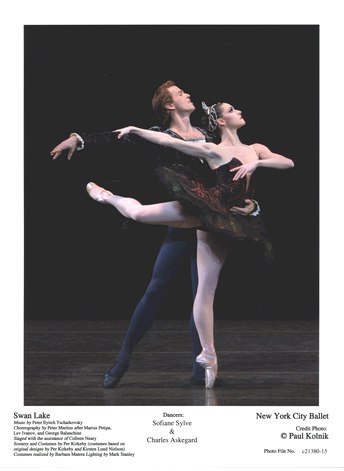|
 |
|
|
 |
 |
New York City Ballet - Swan Lake - As Clear as Black and WhiteLincoln Center
New York, NY
www.nycb.org Richard Penberthy
January 14, 2006 The New York City Ballet's Swan Lake is Peter Martins' version of the classic ballet. He rightly gives credit in the program to previous choreographers Marius Petipa, Lev Ivanov, and George Balanchine, and much of this ballet will look very, very familiar to anyone who has seen other, earlier versions. (In this version, there are two rather than three acts, so it is midway between the early model and the very short Balanchine ballet.) On Saturday, January 14. Sofiane Sylve danced the roles of Odette (white swan)/Odile (black swan). Ms. Sylve was in top form, in absolute control of the performance, summoning both strength and delicacy to her dual role. As Odette, the beautiful girl whom sorcerer von Rotbart has turned into a swan, her first encounter with Prince Siegfried is first tentative, then passionate. Fear and attraction become tremulousness - a constant and delicate bouree and exquisite port de bras endow this swan with believability. As Odile (the black swan and daughter of the sorcerer), the precision of her dancing amplifies the cold deceit with which she seduces the Prince into undoing his pledge to Odette, thereby sealing Odette's fate to remain forever a swan and never return to human form. (In earlier Swan Lakes, the Prince and Odette die.) It is as Odile that Ms. Sylve is called upon to perform the multiple fouette turns (fouettes en tournant). Before some audiences, this has become a hurdle, as if we were watching a track and field event, and this were a qualifying round for a competitive ballerina: she must complete the expected 32 turns. Art, however, is not entirely athleticism, and no one counted whether or not there were thirty-two. There may have been, but that was beside the point, for they were perfect. Mr. Askegard was youthful and suitably petulant and passionate as Prince Siegfried whose coming of age is the cause for all this celebration and tragedy. His partnering was caring and sure. The costumes are very literal and elegant, whereas the set is impressionistic, an odd juxtaposition, but one that is ultimately unimportant. Unfortunately, the black and bright orange cape and headdress of von Rotbart is evocative of a Jack-o'-Lantern, more trick-or-treat than sinister. Daniel Ulbricht, in the role of the Jester, electrified the audience. The sheer boundlessness of his dancing, precision of his repeated rapid patterns - that batterie - as he moves across the stage, height of his jettes, and downright abandon with which he throws himself into spinning tours en l'air is breath-stopping. Mr. Ulbricht's landings are solid and correct. His pirouettes are centered and he stays in place, with no traveling across the stage with each turn. He is an ultimate Jester too in gesture and expression. Laudable performance! In the palace celebrations the children performed engagingly. They were musical, practiced, self-assured, and confident. These young dancers knew themselves to be on stage to perform as professionals, not cute diversions. 
Sofiane Sylve and Charles Askegard in the New York City Ballet's Swan Lake
Photo courtesy of Paul Kolnik

Sofiane Sylve in the New York City Ballet's Swan Lake
Photo courtesy of Paul Kolnik
|
|
|



